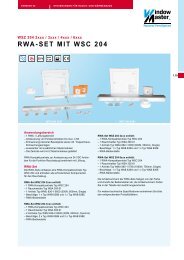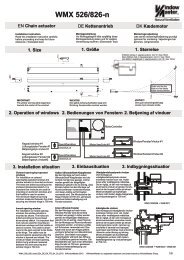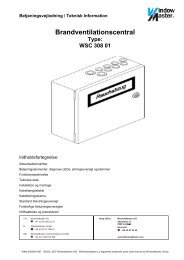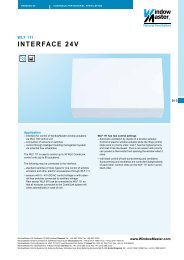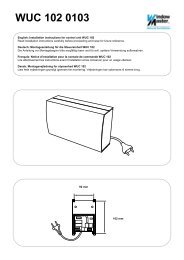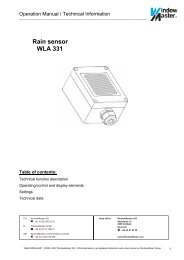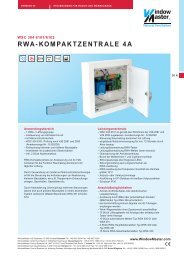ABB i-bus® EIB Universal Interfaces US/U 4.2 US/U ... - WindowMaster
ABB i-bus® EIB Universal Interfaces US/U 4.2 US/U ... - WindowMaster
ABB i-bus® EIB Universal Interfaces US/U 4.2 US/U ... - WindowMaster
Create successful ePaper yourself
Turn your PDF publications into a flip-book with our unique Google optimized e-Paper software.
<strong>ABB</strong> i-bus ® <strong>EIB</strong><br />
<strong>Universal</strong> <strong>Interfaces</strong><br />
<strong>US</strong>/U 2.2, GH Q631 0074 R0111<br />
<strong>US</strong>/U <strong>4.2</strong>, GH Q631 0070 R0111<br />
To improve the control behaviour, the special positions are sometimes not<br />
started or finished immediately but only once a PWM cycle time has elapsed<br />
or after an ON or OFF phase within the cycle. The following table provides<br />
an overview:<br />
Triggering of the Behaviour at start<br />
valve via<br />
Forced positioning Trigger immediately<br />
Behaviour at end<br />
Once an ON or OFF phase has elapsed<br />
Valve purge Trigger immediately Stop immediately<br />
Fault mode Once the cycle has elapsed Once the cycle has elapsed<br />
The sequence in the table simultaneously indicates the priority of the special<br />
positions. Forced positioning has the highest priority.<br />
5.7 Switching sequences<br />
The function “Switching sequence” enables up to five communication objects<br />
(1 bit) to be switched on or off via a single input.<br />
A switching sequence consists of a succession of switching levels which<br />
represent specific object values. An operation of the input switches up or<br />
down one level.<br />
Example:<br />
Switching sequence “sequentially on/off (one push button)”<br />
with three communication objects<br />
Switching level<br />
Value of the communication objects<br />
No. Short code “Value 3” “Value 2” “Value 1”<br />
0 000 OFF OFF OFF<br />
1 001 OFF OFF ON<br />
2 011 OFF ON ON<br />
3 111 ON ON ON<br />
4 011 OFF ON ON<br />
5 001 OFF OFF ON<br />
0 ...<br />
Short code: ...>000>001>011>111>011>001>...<br />
The defined switching sequences stand out due to the fact that only the value<br />
of a single communication object is changed between two switching levels.<br />
The following switching sequences are possible:<br />
“sequentially on/off (one push button)”<br />
This switching sequence switches on another communication object in<br />
succession after each operation. If all the objects are switched on, they are<br />
switched off again in succession – starting with the last object that was<br />
switched on.<br />
“sequentially on/off (several push buttons)”<br />
This switching sequence is similar to the function “sequentially on/off (one<br />
push button)” with the exception that it is only possible to switch up or down<br />
via an input. When the switching sequence has reached the end, further<br />
operations in the same direction are ignored. For this reason, at least two<br />
inputs are necessary for this switching sequence.<br />
45



